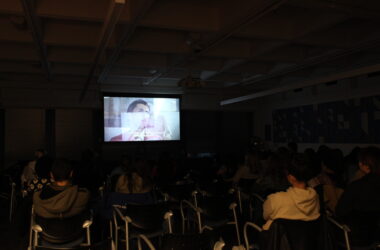Syrian dancer and choreographer Hoor Malas is cloaked in a pink shawl, lying in near-darkness in a fetal-like position on the floor. Malas’s breaths echo through the performance space. Her arm extends weakly, yet with purpose, as she attempts to pull herself over to the singular illuminated light, beaming at her eye-line on the opposite side of the stage. Thus commences the four movements of If My Body Had a Name, a fervent and vulnerable psychosomatic exploration of self through dance.
The contemporary piece, inspired by British author Ken Robinson’s link between the mind and the body, was Malas’s first endeavour as a solo creator. It was produced jointly by Montréal Arts Interculturels (MAI) and Danses de résistances and ran from Nov. 3-5 at MAI. Using Stockholm-based musician Shadi Ali’s compositions and Montrealer Mark Croteau’s lighting designs, If My Body Had a Name addresses Malas’s relationship between her mind and body, investigating the hand and full-body gestures she frequently encountered in Syria during her youth and revealing their influence on her through various life stages.
The first movement portrays Malas in-vitro. In near-darkness and silence, she is a being that has yet to develop, but is already experiencing struggle. Malas pursues light after light––small bulbs that surround the stage floor––each one going dark until, at last, the light remains on, projecting a quasi-birth as Malas removes her shawl. What follows in the second movement is a physical self-realization of infancy and childhood: In one moment, she sits, observing her hand as if just discovering its existence. In the third and fourth movements, Malas examines her adolescence and adulthood, respectively. In my conversation with Malas, she explained that each movement grapples with “a certain amount of time and certain ideology of a place.”
This phenomenon is particularly present and poignant in the third movement. Malas places herself in squares of light on the stage floor—each associated with a specific gesture. In one, she salutes, alluding to the presence of military ideology in her Syrian education. She flits from square to square, frantically repeating motions and poses—a nod to how imposed ideologies harmed her ability to shape her individuality. The movement prompts the audience to consider what forces have influenced their own identities. One member (whom Malas later told me was a friend of hers from Syria) was moved to tears.
If My Body Had a Name showcases ragged, disconnecting movements, with moments of bodily isolation that expose the mind-body struggle endured on her journey of self-discovery. Malas’s talent is evident in the piece’s fluidity. Slower, sharper, articulated motions display her masterful control and quality of movement. The soundtrack seems to inform Malas’s dancing rather than guide it; the two, along with the lighting, are intimately engaged with one another. The piece was obviously rehearsed with purpose, but Malas gives glimpses of improvisation. She incorporates flairs of creativity that add to the piece’s genius and vulnerability as a genuine, stripped expression of the self.
In our conversation, rehearsal director Neil Sochasky described this vulnerability similarly, saying, “[the dance] is very naked […] what made it seem this way is [Malas is] not hiding behind techniques and tricks.”
In If My Body Had a Name, Malas uses dance as an expressive medium similar to that of a diary. Through movement, Malas, jarringly yet gracefully, addresses past traumas and victories. Focusing on the individual mind and body, she extracts herself from the impositions and interpolations of the external. The contemporary choreography, along with her use of Syrian gestures in the piece, resists and reclaims the power that individuals and institutions previously held over her, finding hard-fought peace at the performance’s end. Malas’s connection to dance provides catharsis in dissecting her traumas, but not everyone would approach such journeys similarly. If the mind and body may be reconciled for Malas, perhaps they can be for everyone.









